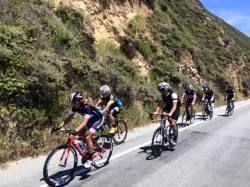In the past, I’ve often talked about the idea of taking some time off, changing your routine or at least letting yourself lose a little fitness during the off-season. Many athletes have never done this and are reluctant to give it a shot. That’s understandable: you’ve worked hard to reach the fitness level you have and the last thing you want to do is let it slip away.
In fact, Robbie has often said, we aren’t pro athletes and even the most compulsive among us doesn’t train that hard by comparison, so there is no need to take four to six weeks off from training. However, if circumstances mean you’ll miss a week or two, that’s nothing to fret over. Time away from structured training allows your body to heal nagging injuries, renews your focus and motivation and most importantly, absolutely won’t hurt--and most likely will help--your long-term performance.
Now that we’ve beaten that horse thoroughly, it’s time to shift gears in our thinking a bit. As the season approaches, training needs to become more regimented and focused. Notice I did not say training needs to increase in volume or become more intense. How those factors interact with your training at this time of year will depend on the timing of your goals, your current fitness level and where you want to be on race day. Armed with that information, you, and possibly your coach, should map out a progression plan that takes you from the present day to race day peak.
Resist the urge to jump into more than you need to do just because you think everyone else is. Your parents likely asked you the age-old question: “If everyone else was jumping off a bridge, would you do that too?” The same logic applies to training. Maybe those “other people” don’t really have a plan. Maybe their goals are completely different from yours. Maybe their training history is different from yours and therefore they can take a different approach to the same goal.
For those with late-season goals (July, August, September), you can afford to be somewhat more patient now. Training should still become a little more focused, mainly on developing well rounded energy systems across the board. That means a little bit of aerobic volume, threshold training, VO2 efforts and some explosive sprints for road racers. Triathletes should still be including some regular VO2 training to build range before shifting focus toward race-specific energy systems a little later in the season. Tri run training should still be emphasizing run durability through short, frequent sessions at an easy pace, often as transition runs following bike workouts. Use the time indoors to focus on high quality training sessions and save the high volume work for warmer weather when you can resume regular outdoor training.
With an early season goal, the ramp rate will need to be a little faster and possibly include a significant amount of high volume sessions on the trainer. This applies to athletes that will be racing a century, 70.3 or Ironman event in May or so. Training during this time of year will need to be fairly specific to your upcoming event. Cyclists may include a little more VO2 and threshold work, while triathletes should be focusing on more threshold and base mileage, along with building run endurance. Although high volume training indoors can be extremely challenging for some from a mental standpoint, take some comfort in knowing that you are able to be much more specific with training and thus get even greater benefit from the time spent indoors.
While now is the time to start taking your training more seriously, think carefully about how fit you want to be right now and how much work you’ll have to do to be as fit as you want to be later. Map out your race program, ideally with one or two A-priority events, a handful of B-priority events and the rest as C-priority events that you use for training and experimentation. Fill in the gaps with the training you’ll need to do.
Nothing is set in stone; this is just a template to help you understand what you’ll need to do. As you train, you’ll need to make adjustments and we’ll talk about how to do that in the next article.

